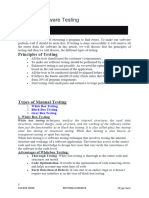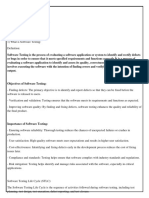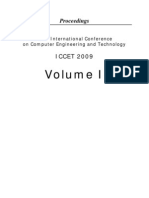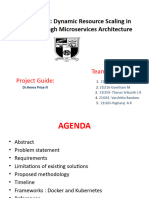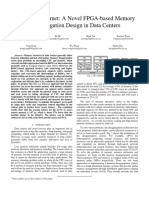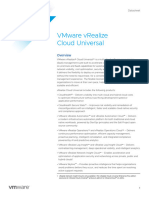0 ratings0% found this document useful (0 votes)
26 views18 pagesTypes of Software Testing
The document discusses various types of software testing, highlighting their importance in the software development life-cycle to ensure quality and reliability. It categorizes testing into manual and automated methods, detailing specific techniques such as white box, black box, and gray box testing, along with their advantages. Additionally, it covers different testing types like functional, non-functional, unit, integration, system, end-to-end, and acceptance testing, emphasizing their roles in validating software applications.
Uploaded by
veedhunramyaCopyright
© © All Rights Reserved
We take content rights seriously. If you suspect this is your content, claim it here.
Available Formats
Download as DOCX, PDF, TXT or read online on Scribd
0 ratings0% found this document useful (0 votes)
26 views18 pagesTypes of Software Testing
The document discusses various types of software testing, highlighting their importance in the software development life-cycle to ensure quality and reliability. It categorizes testing into manual and automated methods, detailing specific techniques such as white box, black box, and gray box testing, along with their advantages. Additionally, it covers different testing types like functional, non-functional, unit, integration, system, end-to-end, and acceptance testing, emphasizing their roles in validating software applications.
Uploaded by
veedhunramyaCopyright
© © All Rights Reserved
We take content rights seriously. If you suspect this is your content, claim it here.
Available Formats
Download as DOCX, PDF, TXT or read online on Scribd
You are on page 1/ 18
Types of Software Testing
Last Updated : 10 Jun, 2025
Software testing is a important of software development life-cycle that
ensures a product works correctly, meets user expectations, and is free of
bugs. There are different types of software testing, each designed to
validate specific aspects of an application, such as functionality,
performance, security, and usability.
In this article, we’ll explore the main types of software testing, their
purpose, and when they are typically used in real-world development and
QA processes.
Principles of Software Testing
Software Testing always aligns with the Customer's Requirement, which
they want. Software testing is an important process that is used for the
enhancement of the Software Quality and Reliability of the application. It is
important to understand the key principle of software testing, which guides
you throughout the process of Software Development.
These principles will be helpful for the tester to identify the software issue
earlier and verify the Software meets to the expectations.
1. Testing Shows the Presence of Defects
2. Exhaustive Testing is Not Possible
3. Early Testing
4. Defect Clustering
5. Pesticide Paradox
6. Testing is Context-Dependent
7. Absence of Errors Fallacy
Read More: Software Testing principle.
Different Types of Software Testing
Here are the Types of Software Testing mainly categorized into the two
domain, which are below.
Types of Software Testing
1. Manual Testing
Manual Testing is a technique to test the software that is carried out using
the functions and features of an application. Which means manual testing
will be check the defect manually with trying one by one function is working
as expected.
Advantages of Manual Testing:
Fast and accurate visual feedback: It detects almost every bug in the
software application and is used to test the dynamically changing GUI
designs like layout, text, etc.
Less expensive: It is less expensive as it does not require any high-
level skill or a specific type of tool.
No coding is required: No programming knowledge is required while
using the black box testing method. It is easy to learn for the new
testers.
Efficient for unplanned changes: Manual testing is suitable in case of
unplanned changes to the application, as it can be adopted easily.
2. Automation Testing
Automated Testing is a technique where the Tester writes scripts
independently and uses suitable Software or Automation Tools to test the
software. It is an Automation Process of a Manual Process. It allows for
executing repetitive tasks without the use of a Manual Tester.
Advantages of Automation Testing:
Simplifies Test Case Execution: Automation testing can be left
virtually unattended and thus it allows monitoring of the results at the
end of the process. Thus, simplifying the overall test execution and
increasing the efficiency of the application.
Improves Reliability of Tests: Automation testing ensures that there is
equal focus on all the areas of the testing, thus ensuring the best quality
end product.
Increases amount of test coverage: Using automation testing, more
test cases can be created and executed for the application under test.
Thus, resulting in higher test coverage and the detection of more bugs.
This allows for the testing of more complex applications and more
features can be tested.
Minimizing Human Interaction: In automation testing, everything is
automated from test case creation to execution thus there are no
changes for human error due to neglect. This reduces the necessity for
fixing glitches in the post-release phase.
Manual vs. Automated testing
Here is the table of comparing Manual Testing and Automated Testing:
Parameters Manual Testing Automation Testing
In manual testing, the test In automated testing, the test
cases are executed by the cases are executed by the
Definition human tester. software tools.
Manual testing is time- Automation testing is faster
Processing Time consuming. than manual testing.
Parameters Manual Testing Automation Testing
Automation testing takes up
Manual testing takes up
automation tools and trained
human resources.
Resources requirement employees.
Exploratory testing is not
Exploratory testing is
possible in automation
possible in manual testing.
Exploratory testing testing.
Automation testing uses
Manual testing doesn’t use
frameworks like Data Drive,
frameworks.
Framework requirement Keyword, etc.
Read More: Manual Testing and Automated Testing.
Types of Manual Testing
1. White Box Testing
White Box Testing is a software testing technique that involves testing the
internal structure and workings of a software application. The tester has
access to the source code and uses this knowledge to design test cases
that can verify the correctness of the software at the code level.
Advantages of White box Testing:
Thorough Testing: White box testing is thorough as the entire code
and structures are tested.
Code Optimization: It results in the optimization of code removing
errors and helps in removing extra lines of code.
Early Detection of Defects: It can start at an earlier stage as it doesn’t
require any interface as in the case of black box testing.
Integration with SDLC: White box testing can be easily started in
the Software Development Life Cycle.
Detection of Complex Defects: Testers can identify defects that
cannot be detected through other testing techniques.
2. Black Box Testing
Black-Box Testing is a type of software testing in which the tester is not
concerned with the internal knowledge or implementation details of the
software but rather focuses on validating the functionality based on the
provided specifications or requirements.
Advantages of Black Box Testing:
The tester does not need to have more functional knowledge or
programming skills to implement the Black Box Testing.
It is efficient for implementing the tests in the larger system.
Tests are executed from the user’s or client’s point of view.
Test cases are easily reproducible.
It is used to find the ambiguity and contradictions in the functional
specifications.
3. Gray Box Testing
Gray Box Testing is a software testing technique that is a combination of
the Black Box Testing technique and the White Box Testing technique.
In the Black Box Testing technique, the tester is unaware of the internal
structure of the item being tested and in White Box Testing the internal
structure is known to the tester.
The internal structure is partially known in Gray Box Testing.
This includes access to internal data structures and algorithms to design
the test cases.
Advantages of Gray Box Testing:
Clarity of goals: Users and developers have clear goals while doing
testing.
Done from a user perspective: Gray box testing is mostly done from
the user perspective.
High programming skills not required: Testers are not required to
have high programming skills for this testing.
Non-intrusive: Gray box testing is non-intrusive.
Improved product quality: Overall quality of the product is improved.
Types of Black Box Testing
1. Functional Testing
Functional Testing is a type of Software Testing in which the system is
tested against the functional requirements and specifications. Functional
testing ensures that the requirements or specifications are properly
satisfied by the application. This type of testing is particularly concerned
with the result of processing. It focuses on the simulation of actual system
usage but does not develop any system structure assumptions. The article
focuses on discussing function testing.
Advantages of Functional Testing:
Bug-free product: Functional testing ensures the delivery of a bug-free
and high-quality product.
Customer satisfaction: It ensures that all requirements are met and
ensures that the customer is satisfied.
Testing focused on specifications: Functional testing is focused on
specifications as per customer usage.
Proper working of application: This ensures that the application works
as expected and ensures proper working of all the functionality of the
application.
Improves quality of the product: Functional testing ensures the
security and safety of the product and improves the quality of the
product.
2. Non-Functional Testing
Non-Functional Testing is a type of Software Testing that is performed to
verify the non-functional requirements of the application. It verifies whether
the behavior of the system is as per the requirement or not. It tests all the
aspects that are not tested in functional testing. Non-functional testing is a
software testing technique that checks the non-functional attributes of the
system. Non-functional testing is defined as a type of software testing to
check non-functional aspects of a software application. It is designed to test
the readiness of a system as per nonfunctional parameters which are never
addressed by functional testing. Non-functional testing is as important as
functional testing.
Advantages of Non-functional Testing:
Improved performance: Non-functional testing checks the performance
of the system and determines the performance bottlenecks that can
affect the performance.
Less time-consuming: Non-functional testing is overall less time-
consuming than the other testing process.
Improves user experience: Non-functional testing like Usability testing
checks how easily usable and user-friendly the software is for the users.
Thus, focus on improving the overall user experience for the application.
More secure product: As non-functional testing specifically includes
security testing that checks the security bottlenecks of the application
and how secure is the application against attacks from internal and
external sources.
Types of Functional Testing
1. Unit Testing
Unit Testing is a method of testing individual units or components of a
software application. It is typically done by developers and is used to
ensure that the individual units of the software are working as intended.
Unit tests are usually automated and are designed to test specific parts of
the code, such as a particular function or method. Unit testing is done at
the lowest level of the software development process where individual units
of code are tested in isolation.
Note: Unit Testing basically Included in both White Box
Testing and Black Box Testing.
Advantages of Unit Testing:
Some of the advantages of Unit Testing are listed below.
It helps to identify bugs early in the development process before they
become more difficult and expensive to fix.
It helps to ensure that changes to the code do not introduce new bugs.
It makes the code more modular and easier to understand and maintain.
It helps to improve the overall quality and reliability of the software.
Note: Some popular frameworks and tools that are used for unit testing
include JUnit , NUnit, and xUnit.
It's important to keep in mind that Unit Testing is only one aspect of
software testing and it should be used in combination with other types of
testing such as integration testing, functional testing, and acceptance
testing to ensure that the software meets the needs of its users.
It focuses on the smallest unit of software design. In this, we test an
individual unit or group of interrelated units. It is often done by the
programmer by using sample input and observing its corresponding
outputs.
Example:
1. In a program we are checking if the loop, method, or function is working
fine.
2. Misunderstood or incorrect, arithmetic precedence.
3. Incorrect initialization.
2. Integration Testing
Integration Testing is a method of testing how different units or components
of a software application interact with each other. It is used to identify and
resolve any issues that may arise when different units of the software are
combined. Integration testing is typically done after unit testing and before
functional testing and is used to verify that the different units of the software
work together as intended.
Different Ways of Performing Integration Testing:
Different ways of Integration Testing are discussed below.
Top-down integration testing: It starts with the highest-level modules and
differentiates them from lower-level modules.
Bottom-up integration testing: It starts with the lowest-level modules and
integrates them with higher-level modules.
Big-Bang integration testing: It combines all the modules and integrates
them all at once.
Incremental integration testing: It integrates the modules in small
groups, testing each group as it is added.
Advantages of Integrating Testing:
It helps to identify and resolve issues that may arise when different units
of the software are combined.
It helps to ensure that the different units of the software work together as
intended.
It helps to improve the overall reliability and stability of the software.
It's important to keep in mind that Integration testing is essential for
complex systems where different components are integrated.
As with unit testing, integration testing is only one aspect of software
testing and it should be used in combination with other types of testing
such as unit testing, functional testing, and acceptance testing to ensure
that the software meets the needs of its users.
The objective is to take unit-tested components and build a program
structure that has been dictated by design. Integration testing is testing in
which a group of components is combined to produce output.
Integration testing is of four types:
1. Top-down
2. Bottom-up
3. Sandwich
4. Big-Bang
Example:
1. Black Box testing: It is used for validation. In this, we ignore internal
working mechanisms and focus on "what is the output?"
2. White box testing: It is used for verification. In this, we focus on
internal mechanisms i.e. how the output is achieved.
3. System Testing
System Testing is a type of software testing that evaluates the overall
functionality and performance of a complete and fully integrated software
solution. It tests if the system meets the specified requirements and if it is
suitable for delivery to the end-users. This type of testing is performed after
the integration testing and before the acceptance testing.
System Testing is a type of software testing that is performed on a
completely integrated system to evaluate the compliance of the system with
the corresponding requirements. In system testing, integration testing
passed components are taken as input. The goal of integration testing is to
detect any irregularity between the units that are integrated.
Advantages of System Testing:
The testers do not require more knowledge of programming to carry out
this testing.
It will test the entire product or software so that we will easily detect the
errors or defects that cannot be identified during the unit testing and
integration testing.
The testing environment is similar to that of the real-time production or
business environment.
It checks the entire functionality of the system with different test scripts
and also it covers the technical and business requirements of clients.
After this testing, the product will almost cover all the possible bugs or
errors and hence the development team will confidently go ahead with
acceptance testing.
4. End-to-end Testing
End-to-End Testing is the type of software testing used to test entire
software from starting to the end along with its integration with external
interfaces. The main purpose of end-to-end testing is to identify system
dependencies and to make sure that the data integrity and communication
with other systems, interfaces and databases to exercise complete
production.
5. Acceptance Testing
Acceptance Testing is formal testing according to user needs,
requirements, and business processes conducted to determine whether a
system satisfies the acceptance criteria or not and to enable the users,
customers, or other authorized entities to determine whether to accept the
system or not.
Advantages of Acceptance Testing:
This testing helps the project team to know the further requirements
from the users directly as it involves the users for testing.
Automated test execution.
It brings confidence and satisfaction to the clients as they are directly
involved in the testing process.
It is easier for the user to describe their requirement.
It covers only the Black-Box testing process and hence the entire
functionality of the product will be tested.
Types of Integration Testing
Here are the Types of Integration testing:
1. Incremental Testing
In Incremental Testing like development, testing is also a phase of SDLC
(Software Development Life Cycle). Different tests are performed at
different stages of the development cycle. Incremental testing is one of the
testing approaches that is commonly used in the software field during the
testing phase of integration testing which is performed after unit testing.
Several stubs and drivers are used to test the modules one after one which
helps in discovering errors and defects in the specific modules.
Advantages of Incremental Testing:
Each module has its specific significance. Each one gets a role to play
during the testing as they are incremented individually.
Defects are detected in smaller modules rather than denoting errors and
then editing and re-correcting large files.
It’s more flexible and cost-efficient as per requirements and scopes.
The customer gets the chance to respond to each building.
There are 2 Types of Incremental Testing
1. Top-down Integration Testing
Top-down Integration Testing is a type of incremental integration testing
approach in which testing is done by integrating or joining two or more
modules by moving down from top to bottom through the control flow of the
architecture structure. In these, high-level modules are tested first, and
then low-level modules are tested. Then, finally, integration is done to
ensure that the system is working properly. Stubs and drivers are used to
carry out this project. This technique is used to increase or stimulate the
behavior of Modules that are not integrated into a lower level.
Advantages Top Down Integration Testing:
There is no need to write drivers.
Interface errors are identified at an early stage and fault localization is
also easier.
Low-level utilities that are not important are not tested well and high-
level testers are tested well in an appropriate manner.
Representation of test cases is easier and simpler once Input-Output
functions are added.
2. Bottom-up Integration Testing
Bottom-up Integration Testing is a type of incremental integration testing
approach in which testing is done by integrating or joining two or more
modules by moving upward from bottom to top through the control flow of
the architecture structure. In these, low-level modules are tested first, and
then high-level modules are tested. This type of testing or approach is also
known as inductive reasoning and is used as a synthesis synonym in many
cases. Bottom-up testing is user-friendly testing and results in an increase
in overall software development. This testing results in high success rates
with long-lasting results.
Advantages of Bottom-up Integration Testing:
It is easy and simple to create and develop test conditions.
It is also easy to observe test results.
It is not necessary to know about the details of the structural design.
Low-level utilities are also tested well and are also compatible with the
object-oriented structure.
Types of Non-functional Testing
Here are the Types of Non-Functional Testing
1. Performance Testing
Performance Testing is a type of software testing that ensures software
applications perform properly under their expected workload. It is a testing
technique carried out to determine system performance in terms of
sensitivity, reactivity, and stability under a particular workload.
Advantages of Performance Testing:
Performance testing ensures the speed, load capability, accuracy, and
other performances of the system.
It identifies, monitors, and resolves the issues if anything occurs.
It ensures the great optimization of the software and also allows many
users to use it at the same time.
It ensures the client as well as the end-customer’s satisfaction.
Performance testing has several advantages that make it an important
aspect of software testing:
Identifying bottlenecks : Performance testing helps identify
bottlenecks in the system such as slow database queries, insufficient
memory, or network congestion. This helps developers optimize the
system and ensure that it can handle the expected number of users or
transactions.
2. Usability Testing
Usability Testing in software testing is a type of testing, that is done from an
end user’s perspective to determine if the system is easily usable. Usability
testing is generally the practice of testing how easy a design is to use on a
group of representative users. Several tests are performed on a product
before deploying it.
Advantages and Disadvantages of Usability Testing:
Usability testing is preferred to evaluate a product or service by testing it
with the proper users. In Usability testing, the development and design
teams will use to identify issues before coding and the result will be earlier
issues will be solved.
User-Centric Design: By involving actual users in the testing process,
you ensure that your product or website is designed with their needs
and preferences in mind.
Identifying User Pain Points: Usability testing helps uncover areas
where users struggle or encounter difficulties while interacting with your
product. This insight allows you to address these pain points and
improve the overall user experience.
Optimizing User Interface: Through usability testing, you can evaluate
the effectiveness of your user interface (UI) design, including layout,
navigation, and interactive elements. This enables you to refine and
optimize the UI for better usability.
Enhancing User Satisfaction: By addressing usability issues and
making improvements based on user feedback, you can enhance user
satisfaction and loyalty, leading to increased engagement and retention.
3. Compatibility Testing
Compatibility Testing is software testing that comes under the non
functional testing category, and it is performed on an application to check
its compatibility (running capability) on different platforms/environments.
This testing is done only when the application becomes stable. This means
simply this compatibility test aims to check the developed software
application functionality on various software, hardware platforms, networks
browser etc. This compatibility testing is very important in product
production and implementation point of view as it is performed to avoid
future issues regarding compatibility.
Advantages of Compatibility Testing:
It ensures complete customer satisfaction.
It provides service across multiple platforms.
Identifying bugs during the development process.
Types of Performance Testing
Here are the Types of Performance testing:
1. Load Testing
Load Testing determines the behavior of the application when multiple
users use it at the same time. It is the response of the system measured
under varying load conditions.
1. The load testing is carried out for normal and extreme load conditions.
2. Load testing is a type of performance testing that simulates a real-world
load on a system or application to see how it performs under stress.
3. The goal of load testing is to identify bottlenecks and determine the
maximum number of users or transactions the system can handle.
4. It is an important aspect of software testing as it helps ensure that the
system can handle the expected usage levels and identify any potential
issues before the system is deployed to production.
Advantages of Load Testing:
Load testing has several advantages that make it an important aspect of
software testing:
Identifying bottlenecks: Load testing helps identify bottlenecks in the
system such as slow database queries, insufficient memory, or network
congestion. This helps developers optimize the system and ensure that
it can handle the expected number of users or transactions.
Improved scalability: By identifying the system’s maximum capacity,
load testing helps ensure that the system can handle an increasing
number of users or transactions over time. This is particularly important
for web-based systems and applications that are expected to handle a
high volume of traffic.
Improved reliability: Load testing helps identify any potential issues
that may occur under heavy load conditions, such as increased error
rates or slow response times. This helps ensure that the system is
reliable and stable when it is deployed to production.
2. Stress Testing
Stress Testing is defined as types of software testing that verifies the
stability and reliability of the system. This test particularly determines the
system’s robustness and error handling under the burden of some load
conditions. It tests beyond the normal operating point and analyses how the
system works under extreme conditions.
Example:
1. Test cases that require maximum memory or other resources are
executed.
2. Test cases that may cause thrashing in a virtual operating system.
3. Test cases that may cause excessive disk requirement Performance
Testing.
It is designed to test the run-time performance of software within the
context of an integrated system. It is used to test the speed and
effectiveness of the program. It is also called load testing. In it, we check,
what is the performance of the system in the given load.
Example:
Checking several processor cycles.
3. Scalability Testing
Scalability Testing is a type of non-functional testing in which the
performance of a software application, system, network or process is tested
in terms of its capability to scale up or scale down the number of user
request load or other such performance attributes. It can be carried out at a
hardware, software or database level.
Advantages of Scalability Testing:
It provides more accessibility to the product.
It detects issues with web page loading and other performance issues.
It finds and fixes the issues earlier in the product which saves a lot of
time.
It ensures the end-user experience under the specific load. It provides
customer satisfaction.
It helps in effective tool utilization tracking.
4. Stability Testing
Stability Testing is a type of Software Testing to check the quality and
behavior of the software in different environmental parameters. It is defined
as the ability of the product to continue to function over time without failure.
Stability testing assesses stability problems. This testing is mainly intended
to check whether the application will crash at any point in time or not.
Advantages of Stability Testing:
It gives the limit of the data that a system can handle practically.
It provides confidence on the performance of the system.
It determines the stability and robustness of the system under load.
Stability testing leads to a better end-user experience.
Other Types of Testing
1. Smoke Testing
Smoke Testing is done to make sure that the software under testing is
ready or stable for further testing
It is called a smoke test as the testing of an initial pass is done to check if it
did not catch fire or smoke in the initial switch-on.
Example:
If the project has 2 modules so before going to the module make sure that
module 1 works properly.
Advantages of Smoke Testing:
Smoke testing is easy to perform.
It helps in identifying defects in the early stages.
It improves the quality of the system.
Smoke testing reduces the risk of failure.
Smoke testing makes progress easier to access.
2. Sanity Testing
Sanity Testing is a subset of regression testing. Sanity testing is performed
to ensure that the code changes that are made are working properly. Sanity
testing is a stoppage to check whether testing for the build can proceed or
not. The focus of the team during the sanity testing process is to validate
the functionality of the application and not detailed testing. Sanity testing is
generally performed on a build where the production deployment is
required immediately like a critical bug fix.
Advantages of Sanity Testing:
Sanity testing helps to quickly identify defects in the core functionality.
It can be carried out in less time as no documentation is required for
sanity testing.
If the defects are found during sanity testing, the project is rejected
which is helpful in saving time for execution of regression tests.
This testing technique is not so expensive when compared to another
type of testing.
It helps to identify the dependent missing objects.
3. Regression Testing
Regression testing is a way to check if recent code changes have affected
the existing features of a software application. It ensures that everything
still works fine after updates or bug fixes.
Regression testing can be performed in different ways, such as:
Retesting – Checking the entire application or specific features that
were affected by the changes.
Re-execution – Running previously tested cases to make sure
everything still functions properly.
Comparison – Comparing the latest version of the software with an
older version to ensure no features are broken.
Advantages of Regression Testing:
Prevents New Bugs – Ensures that software updates, bug fixes, or new
features do not break existing functionality.
Keeps Software Reliable – Confirms that the software continues to
work as expected after any changes.
Improves Stability – Regular regression testing helps maintain the
overall stability and performance of the software.
Every time a new module is added leads to changes in the program. This
type of testing makes sure that the whole component works properly even
after adding components to the complete program.
Example:
In school records, suppose we have module staff, students, and finance
combining these modules and checking if the integration of these modules
works fine in regression testing.
4. Acceptance Testing
Acceptance testing is done by the customers to check whether the
delivered products perform the desired tasks or not, as stated in the
requirements. We use Object-Oriented Testing for discussing test plans
and for executing the projects.
Advantages of Acceptance Testing:
This testing helps the project team to know the further requirements of
the users directly as it involves the users for testing.
Automated test execution.
It brings confidence and satisfaction to the clients as they are directly
involved in the testing process.
It is easier for the user to describe their requirement.
It covers only the Black-Box testing process and hence the entire
functionality of the product will be tested.
5. User Acceptance Testing
User Acceptance Testing (UAT) serves the purpose of ensuring that the
software meets the business requirements and is ready
for deployment by validating its functionality in a real-world environment. It
allows end-users to test the software to ensure it meets their needs and
operates as expected, helping to identify and fix any issues before the final
release.
Advantages of User Acceptance testing:
Ensures the Software Meets User Needs: UAT helps make sure the
software does what the end-users expect and addresses their business
needs, which increases the chances of a successful launch.
Uncovers Real-World Issues: Since actual users carry out UAT, it can
uncover real-world problems that developers might not have thought of.
This ensures the software works in the way users need it to.
Boosts User Satisfaction: By getting feedback from users early on,
UAT helps shape the product into something that meets their
expectations. The result is a happier and more satisfied user base.
Reduces Post-Release Surprises: By catching issues before the
software is released, UAT helps minimize the risk of bugs or broken
features that could appear once it’s live.
Builds Confidence in the Product: When users test and approve the
software, it builds confidence in the product, ensuring it’s ready for the
final release.
6. Exploratory Testing
Exploratory Testing is a type of software testing in which the tester is free
to select any possible methodology to test the software. It is an unscripted
approach to software testing. In exploratory testing, software developers
use their learning, knowledge, skills, and abilities to test the software
developed by themselves.
Advantages of Exploratory Testing:
Less preparation required: It takes no preparation as it is an
unscripted testing technique.
Finds critical defects: Exploratory testing involves an investigation
process that helps to find critical defects very quickly.
Improves productivity: In exploratory testing, testers use their
knowledge, skills, and experience to test the software. It helps to expand
the imagination of the testers by executing more test cases, thus
enhancing the overall quality of the software.
7. Adhoc Testing
Adhoc Testing is a type of software testing that is performed informally and
randomly after the formal testing is completed to find any loophole in the
system. For this reason, it is also known as Random or Monkey testing.
Adhoc testing is not performed in a structured way so it is not based on any
methodological approach. That’s why Adhoc testing is a type of
Unstructured Software Testing.
Advantages of Adhoc testing:
The errors that can not be identified with written test cases can be
identified by Adhoc testing.
It can be performed within a very limited time.
Helps to create unique test cases.
This test helps to build a strong
You might also like
- E-Notes 32820 Content Document 20250313054541PMNo ratings yetE-Notes 32820 Content Document 20250313054541PM85 pages
- Software Testing - 20241020 - 172949 - 0000No ratings yetSoftware Testing - 20241020 - 172949 - 00008 pages
- (CMP-DVA) AWS Certified Developer - AssociateNo ratings yet(CMP-DVA) AWS Certified Developer - Associate863 pages
- Rapid Bottleneck Identification: A Better Way To Load TestNo ratings yetRapid Bottleneck Identification: A Better Way To Load Test8 pages
- h12642 WP Emc Vplex Leveraging Native and Array Based Copy TechnologiesNo ratings yeth12642 WP Emc Vplex Leveraging Native and Array Based Copy Technologies51 pages
- CXL Over Ethernet A Novel FPGA-based MemoryNo ratings yetCXL Over Ethernet A Novel FPGA-based Memory9 pages
- System Design - Sequencer - Grokking Modern System Design Interview For Engineers & Managers33% (6)System Design - Sequencer - Grokking Modern System Design Interview For Engineers & Managers1 page
- Design and Development of Billing Module For DRMNo ratings yetDesign and Development of Billing Module For DRM9 pages
- ARTICLE - Is Agentic RAG Worth The Investment? Agentic RAG Pricing and ROI BreakdownNo ratings yetARTICLE - Is Agentic RAG Worth The Investment? Agentic RAG Pricing and ROI Breakdown1 page
- Lecture 3 Understanding Cloud ComputingNo ratings yetLecture 3 Understanding Cloud Computing50 pages
- Graph Convolutional Neural Networks For Web-Scale Recommender SystemsNo ratings yetGraph Convolutional Neural Networks For Web-Scale Recommender Systems10 pages













